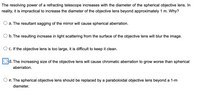
College Physics
11th Edition
ISBN: 9781305952300
Author: Raymond A. Serway, Chris Vuille
Publisher: Cengage Learning
expand_more
expand_more
format_list_bulleted
Question

Transcribed Image Text:The resolving power of a refracting telescope increases with the diameter of the spherical objective lens. In
reality, it is impractical to increase the diameter of the objective lens beyond approximately 1 m. Why?
a. The resultant sagging of the mirror will cause spherical aberration.
O b. The resulting increase in light scattering from the surface of the objective lens will blur the image.
c. If the objective lens is too large, it is difficult to keep it clean.
d. The increasing size of the objective lens will cause chromatic aberration to grow worse than spherical
aberration.
O e. The spherical objective lens should be replaced by a paraboloidal objective lens beyond a 1-m
diameter.
Expert Solution
This question has been solved!
Explore an expertly crafted, step-by-step solution for a thorough understanding of key concepts.
Step by stepSolved in 2 steps

Knowledge Booster
Learn more about
Need a deep-dive on the concept behind this application? Look no further. Learn more about this topic, physics and related others by exploring similar questions and additional content below.Similar questions
- Which of the following is not a problem for refracting telescopes? O A. Different wavelengths of light are focused at slightly different locations. O B. The quality of the glass lens in transparency and in the shape of both surfaces must be high. C. The secondary mirror blocks some of the light passing through the primary lens. D. The primary lens can only be supported at the edges making deformation of large lenses difficult to avoid.arrow_forward1. Which of following statement regarding non-linear optics is incorrect? A. Refractive index can depend on light intensity. B. Two light beams are independent and cannot control each other. C. It can produce second harmonic generation with light frequency doubled (2w). D. It can produce sum-frequency generation of two incident light beams (@3 = w1 + w2). %3Darrow_forwardA camera lens used for taking close-up photographs has a focal length of 21 mm. The farthest it can be placed from the film is 33.3 mm. a. What is the closest object that can be photographed? mm b. What is the magnification of this closest object? Xarrow_forward
- Create a ray diagram for eyeglasses that contain a diverging lens. Assume you are looking at a 2 cm tall object that is 4 cm from the lens. The focal length is 3 cm. What type of vision are they used to correct? Give both names. How do they do this? Explain.arrow_forwardProblem 8: The objective lens of the refracting telescope at the Lick Observatory in California has a focal length of 57 ft. a. What is the refractive power of this lens? b. What focal length (mm) eyepiece would give a magnification of 1000X for this telescope?arrow_forwardm 18 An amateur astronomer wants to build a small refracting telescope. The only lenses available to him have focal lengths of 7.00 cm, 12.0 cm, 19.0 cm, and 32.0 cm. H Q Search Part A What is the greatest magnification that can be obtained using two of these lenses M = Submit Part B —| ΑΣΦ L = Request Answer How long is the telescope with the greatest magnification? -- ΑΣΦ ? cm 6:27 12/5/20arrow_forward
arrow_back_ios
arrow_forward_ios
Recommended textbooks for you
 College PhysicsPhysicsISBN:9781305952300Author:Raymond A. Serway, Chris VuillePublisher:Cengage Learning
College PhysicsPhysicsISBN:9781305952300Author:Raymond A. Serway, Chris VuillePublisher:Cengage Learning University Physics (14th Edition)PhysicsISBN:9780133969290Author:Hugh D. Young, Roger A. FreedmanPublisher:PEARSON
University Physics (14th Edition)PhysicsISBN:9780133969290Author:Hugh D. Young, Roger A. FreedmanPublisher:PEARSON Introduction To Quantum MechanicsPhysicsISBN:9781107189638Author:Griffiths, David J., Schroeter, Darrell F.Publisher:Cambridge University Press
Introduction To Quantum MechanicsPhysicsISBN:9781107189638Author:Griffiths, David J., Schroeter, Darrell F.Publisher:Cambridge University Press Physics for Scientists and EngineersPhysicsISBN:9781337553278Author:Raymond A. Serway, John W. JewettPublisher:Cengage Learning
Physics for Scientists and EngineersPhysicsISBN:9781337553278Author:Raymond A. Serway, John W. JewettPublisher:Cengage Learning Lecture- Tutorials for Introductory AstronomyPhysicsISBN:9780321820464Author:Edward E. Prather, Tim P. Slater, Jeff P. Adams, Gina BrissendenPublisher:Addison-Wesley
Lecture- Tutorials for Introductory AstronomyPhysicsISBN:9780321820464Author:Edward E. Prather, Tim P. Slater, Jeff P. Adams, Gina BrissendenPublisher:Addison-Wesley College Physics: A Strategic Approach (4th Editio...PhysicsISBN:9780134609034Author:Randall D. Knight (Professor Emeritus), Brian Jones, Stuart FieldPublisher:PEARSON
College Physics: A Strategic Approach (4th Editio...PhysicsISBN:9780134609034Author:Randall D. Knight (Professor Emeritus), Brian Jones, Stuart FieldPublisher:PEARSON

College Physics
Physics
ISBN:9781305952300
Author:Raymond A. Serway, Chris Vuille
Publisher:Cengage Learning

University Physics (14th Edition)
Physics
ISBN:9780133969290
Author:Hugh D. Young, Roger A. Freedman
Publisher:PEARSON

Introduction To Quantum Mechanics
Physics
ISBN:9781107189638
Author:Griffiths, David J., Schroeter, Darrell F.
Publisher:Cambridge University Press

Physics for Scientists and Engineers
Physics
ISBN:9781337553278
Author:Raymond A. Serway, John W. Jewett
Publisher:Cengage Learning

Lecture- Tutorials for Introductory Astronomy
Physics
ISBN:9780321820464
Author:Edward E. Prather, Tim P. Slater, Jeff P. Adams, Gina Brissenden
Publisher:Addison-Wesley

College Physics: A Strategic Approach (4th Editio...
Physics
ISBN:9780134609034
Author:Randall D. Knight (Professor Emeritus), Brian Jones, Stuart Field
Publisher:PEARSON